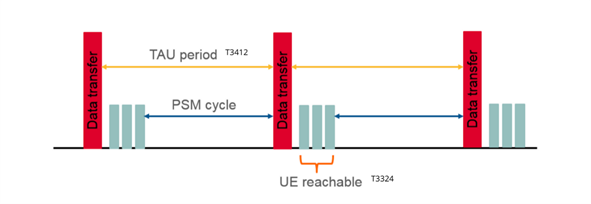
One of the key benefits that NB-IoT and LTE-M networks enable is greatly reduced device power consumption allowing devices to have battery lives measured in years. The two features which NB-IoT and LTE-M networks use to reduce device power consumption are PSM (Power Saving Mode) and eDRX (Extended Discontinuous Reception).
In this blog post, Arkessa’s Hao Shi takes a deeper dive into these 2 features to see how they enable devices to reduce their power consumption.
PSM (Power Saving Mode)
PSM or Power Saving Mode allows the device to disable its cellular radio and ‘sleep’ in a lower power mode while remaining registered to the network. It has always been possible for a mobile device to turn off its cellular radio to conserve battery power. However, upon turning its cellular radio back on, the device would subsequently need to go through the complete reattach procedure to reconnect to the network. The reattach procedure consumes a small amount of energy, but the cumulative energy consumption of reattaches over the lifetime of a device can become significant. Therefore, if this procedure can be avoided then battery life can be extended significantly.
To enable PSM, both the network and mobile device need to support this feature. During the Attach or Tracking Area Update procedures, the mobile device activates PSM by negotiating two timers with the network. These are T3324 Active Timer and T3412 Extended periodic Tracking Area Update timer. The network may accept these timer values or set new ones. The network can also reject the request entirely if the network does not support PSM. The length of time a device can remain in Power Saving Mode is the difference between these 2 timers (T3412 – T3324).


Diagram adapted from GSMA (Source)
T3412 Extended Timer
The T3412 timer, also known as the periodic Tracking Area Update (TAU) timer, determines the periodicity of the mobile device availability to the network. A longer periodic TAU timer is possible using T3412 extended timer. As per the latest version of 3GPP TS 24.008, the maximum value of T3412 extended timer is “35712000” seconds or just over 413 days.
T3324 Active Timer
The T3324 Active Timer determines the duration during which the mobile device remains reachable by the network. The mobile device starts the Active Timer when it moves from connected to idle mode. When the Active Timer expires, the device moves to Power Saving Mode. A mobile device using PSM is reachable for Mobile Terminated services only for the duration of the Active Timer after a Mobile Originated event such as data transfer.
The maximum value of the T3324 Active Timer is “11160” seconds or 186 minutes.
eDRX (Extended Discontinuous Reception)
Extended Discontinuous Reception (eDRX) is an extension of the existing LTE feature, Discontinuous Reception, which can be used by IoT devices to reduce power consumption even further. eDRX can be used without PSM or in conjunction with PSM to obtain additional power savings.
Many mobile devices nowadays already use Discontinuous Reception (DRX) to extend battery life by momentarily switching off the receive side of the cellular module for a fraction of a second. While the receive side of the cellular module is switched off, the mobile device is not listening to the network so it is not reachable. However, if this period of time is kept short, the mobile device user will not experience any noticeable degradation in service.
For an IoT application, it would probably be quite acceptable for the mobile device to not be reachable for several seconds or longer. eDRX allows the time interval during which a device is not listening to the network to be greatly extended.
Whilst not providing the same levels of power reduction as PSM, for some applications eDRX may provide a good compromise between device reachability and power consumption.


Diagram adapted from GSMA (Source)
In order to use the eDRX feature, the mobile device requests the eDRX parameters during the ATTACH and TAU procedures. The mobile network may or may not accept the mobile device’s request based on what has been configured on the network. The network can also propose different eDRX parameters to what has been requested. The mobile device must always apply the parameters transmitted by the network.
Once the eDRX parameters have been successfully negotiated between the mobile device and network, the network will know when the mobile device can be reached and paged. During eDRX, any data or messages sent to the device will be queued and delivered to the mobile device when its receiver turns back on.
| eDRx cycle length |
| 20.48 seconds |
| 40.96 seconds |
| 81.92 seconds |
| 163.84 seconds (~ 3 min) |
| 327.68 seconds (~ 5 min) |
| 655.36 seconds (~ 11 min) |
| 1310.72 seconds (~22 min) |
| 2621.44 seconds (~44 min) |
| 5242.88 seconds (~87 min) |
| 10485.76 seconds (~175 min) |
PSM and eDRX are complementary features and using both will achieve the maximum power savings and device battery life. However, users should be aware of the effects of PSM and eDRX on device reachability and achieve the correct balance for the IoT application. As mentioned earlier, users also need to be aware that even though a device can support and request the use of both PSM and eDRX, it is ultimately up to the network to reject the request, enable one feature or both.
Arkessa offers an extensive NB-IoT footprint in Europe and across the globe, giving our customers freedom to test and deploy their low-data, high-density applications wherever they are in the world.
Our technical teams are on hand to answer any questions and to find the right solution for your IoT application. To find out more about LPWAN technologies and to order a trial pack, contact our specialist team on connect@arkessa.com.